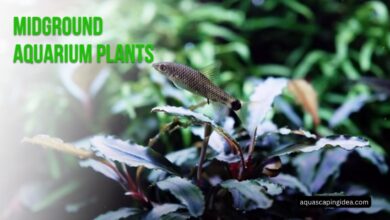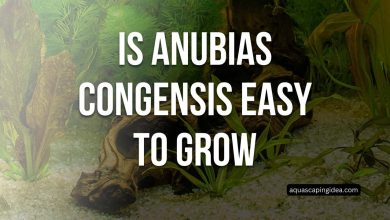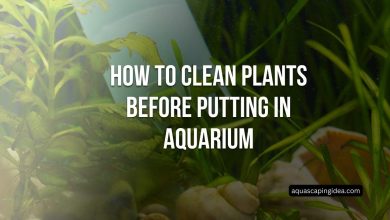Can You Plant Anubias in Substrate?
Anubias, the versatile and hardy aquarium plant, has captured the hearts of many aquarists. But when it comes to planting this beloved species, a common question arises: Can you plant Anubias in substrate? This comprehensive guide will dive deep into the world of Anubias, exploring its unique characteristics, ideal growing conditions, and the pros and cons of planting it in substrate.
The Anubias Enigma
Anubias, a genus of aquatic and semi-aquatic flowering plants, has become a staple in the aquarium hobby. Known for its lush green leaves and ability to thrive in various conditions, Anubias presents a unique planting challenge. While many aquatic plants are typically rooted in substrate, Anubias has sparked debates among enthusiasts about the best way to cultivate it.
In this article, we’ll explore the intricacies of Anubias care, focusing on the central question: Can you plant Anubias in substrate? We’ll examine the plant’s natural habitat, its growth patterns, and the potential benefits and drawbacks of different planting methods. By the end, you’ll have a comprehensive understanding of how to best care for your Anubias, whether you choose to plant it in substrate or explore alternative methods.
Understanding Anubias: Nature’s Resilient Beauty
The Anubias Family: Diversity in Green
Anubias is a genus comprising approximately 13-15 species, all native to tropical central and western Africa. Some of the most popular species in the aquarium trade include:
- Anubias barteri
- Anubias nana
- Anubias coffeefolia
- Anubias hastifolia
- Anubias gilletii
Each species has its unique characteristics, but they all share common traits that make them beloved among aquarists.
Natural Habitat: Clues from the Wild
In their natural habitats, Anubias plants are typically found growing:
- Along riverbanks
- In swamps
- On rocks in fast-flowing streams
- Attached to tree roots or fallen logs in shallow waters
Importantly, Anubias plants in the wild are often found growing epiphytically – attached to surfaces rather than rooted in soil. This natural growth pattern provides valuable insights into their care in aquariums.
Anatomy of Anubias: Built for Adaptation
Understanding the anatomy of Anubias is crucial to making informed decisions about planting methods:
- Rhizome: The thick, horizontal stem from which leaves and roots grow.
- Roots: Adventitious roots that grow from the rhizome, primarily used for anchoring.
- Leaves: Thick, waxy leaves that are resistant to algae growth.
- Slow Growth Rate: Anubias is known for its slow but steady growth.
This unique structure allows Anubias to adapt to various growing conditions, including both substrate and non-substrate environments.
The Great Debate: Substrate vs. Non-Substrate Planting
Option 1: Planting Anubias in Substrate
Pros of Substrate Planting
- Natural Appearance: Substrate-planted Anubias can create a more natural, rooted look in your aquascape.
- Stability: When properly planted, substrate can provide good stability for the plant.
- Nutrient Access: Substrate, especially enriched aquarium soil, can provide additional nutrients.
Cons of Substrate Planting
- Risk of Rhizome Burial: The most significant risk is accidentally burying the rhizome, which can lead to rot.
- Reduced Water Flow: Substrate may reduce water flow around the roots and rhizome.
- Difficulty in Repositioning: Once planted in substrate, moving the Anubias can be disruptive to the aquascape.
Option 2: Non-Substrate Planting Methods
Pros of Non-Substrate Planting
- Optimal Growth: Mimics natural epiphytic growth patterns.
- Reduced Risk of Rot: Keeps the rhizome exposed, minimizing the risk of rot.
- Flexibility: Easily reposition or propagate the plant.
Cons of Non-Substrate Planting
- Aesthetic Limitations: May not achieve the “rooted” look some aquascapers prefer.
- Initial Stability Challenges: It may take time for the plant to attach firmly to surfaces.
- Potential Nutrient Deficiencies: Relies more heavily on water column fertilization.
The Verdict: Can You Plant Anubias in Substrate?
The short answer is: Yes, you can plant Anubias in substrate, but it requires careful consideration and proper technique.
Best Practices for Substrate Planting
If you choose to plant Anubias in substrate, follow these guidelines:
- Partial Planting: Only plant the roots in the substrate, leaving the rhizome exposed.
- Anchoring: Use plant weights or fishing line to secure the plant until roots establish.
- Substrate Choice: Opt for a well-draining substrate to prevent waterlogging.
- Regular Inspection: Check regularly to ensure the rhizome hasn’t become buried.
Alternative Planting Methods
Consider these popular non-substrate methods:
- Attaching to Hardscape: Use cotton thread or cyanoacrylate glue to attach Anubias to driftwood or rocks.
- Wedging: Gently wedge the rhizome between rocks or in crevices of driftwood.
- Floating: Allow smaller Anubias species to float, developing roots over time.
Optimizing Anubias Growth: Beyond Planting Methods
Regardless of your chosen planting method, consider these factors for optimal Anubias growth:
Lighting Requirements
Anubias thrives in low to moderate light conditions:
- Avoid direct, intense light to prevent algae growth on leaves.
- Aim for 10-20 PAR (Photosynthetically Active Radiation) for most Anubias species.
- Consider shading from other plants or hardscape elements.
Water Parameters
Anubias is adaptable but prefers:
- Temperature: 72-82°F (22-28°C)
- pH: 6.0-7.5
- Water Hardness: 3-8 dKH
Fertilization
While Anubias is not a heavy feeder, it benefits from:
- Regular liquid fertilization for water column feeders
- Root tabs near the roots if planted in substrate
- Balanced macro and micronutrients
CO2 Supplementation
- Not essential but can promote faster growth and more vibrant leaves
- Use with caution, as high CO2 levels can lead to algae issues on slow-growing Anubias
Pruning and Maintenance
- Remove yellowing or damaged leaves promptly
- Trim roots if they become excessively long
- Propagate by dividing the rhizome to control size and shape
Troubleshooting Common Anubias Issues
Problem: Yellowing Leaves
Possible Causes:
- Nutrient deficiency
- Too much light
- Age (natural leaf senescence)
Solution: Adjust fertilization, reduce light intensity, and remove old leaves.
Problem: Slow Growth
Possible Causes:
- Insufficient nutrients
- Poor water quality
- Inadequate lighting
Solution: Ensure proper fertilization, maintain water quality, and optimize lighting conditions.
Problem: Algae Growth on Leaves
Possible Causes:
- Excessive light
- Nutrient imbalance
- Poor water circulation
Solution: Reduce light intensity, balance nutrients, and improve water flow around the plant.
Problem: Rhizome Rot
Possible Causes:
- Buried rhizome
- Poor water quality
- Physical damage
Solution: Ensure rhizome is exposed, improve water quality, and handle the plant gently.
Anubias in Aquascaping: Design Inspirations
Anubias’ versatility makes it a favorite among aquascapers. Here are some creative ways to incorporate Anubias into your aquarium design:
- Foreground Accent: Use smaller species like Anubias nana ‘Petite’ to create lush, low-growing foregrounds.
- Midground Texture: Larger Anubias species can add texture and depth to the midground of your aquascape.
- Epiphyte Gardens: Create stunning epiphyte displays by grouping different Anubias species on hardscape.
- Natural Canopy: Allow Anubias to grow on elevated hardscape, creating a natural canopy effect.
- Contrast Element: Use the dark green leaves of Anubias to contrast with red or light green plants.
Anubias and Tank Mates: Creating a Harmonious Ecosystem
Anubias is known for its compatibility with a wide range of aquarium inhabitants:
Fish Compatibility
- Ideal for community tanks with peaceful fish
- Provides hiding spots for shy species
- Resistant to nibbling from herbivorous fish
Invertebrate Friends
- Excellent habitat for shrimp and snails
- Broad leaves provide grazing surfaces for algae-eating species
Plant Combinations
- Pairs well with other slow-growing plants like Java Fern and Bucephalandra
- Can be used to provide shade for lower light plants
FAQ: Your Anubias Questions Answered
Q: How often should I fertilize my Anubias?
A: Fertilize weekly with a balanced liquid fertilizer, adjusting based on plant growth and water parameters.
Q: Can Anubias grow fully submerged?
A: Yes, Anubias can grow fully submerged and is primarily used as an aquatic plant in aquariums.
Q: How do I propagate Anubias?
A: Propagate by cutting the rhizome into sections, ensuring each section has at least 3-4 leaves and some roots.
Q: Is Anubias suitable for beginners?
A: Absolutely! Anubias is one of the most forgiving and low-maintenance aquarium plants, making it ideal for beginners.
Q: Can Anubias grow in a fish bowl or small tank?
A: Yes, Anubias, especially smaller varieties, can thrive in fish bowls and nano tanks due to its slow growth and low light requirements.
Conclusion: Embracing the Versatility of Anubias
As we’ve explored throughout this comprehensive guide, the question “Can you plant Anubias in substrate?” doesn’t have a simple yes or no answer. While it is possible to plant Anubias in substrate, the key lies in understanding the plant’s natural growth habits and adapting our care methods accordingly.
Whether you choose to plant your Anubias in substrate or opt for alternative methods, success lies in providing the right conditions and attentive care. The versatility of Anubias allows for creativity in aquascaping, making it a valuable addition to any aquarium, regardless of size or style.
Remember, the best planting method for your Anubias ultimately depends on your specific aquarium setup, aesthetic preferences, and maintenance routine. By considering the pros and cons of each method and following best practices, you can ensure that your Anubias not only survives but thrives, contributing to a beautiful and healthy aquatic ecosystem.
As you embark on your Anubias growing journey, don’t be afraid to experiment with different planting techniques and aquascaping designs. With its resilience and adaptability, Anubias offers endless possibilities for creating stunning underwater landscapes. Happy planting!



